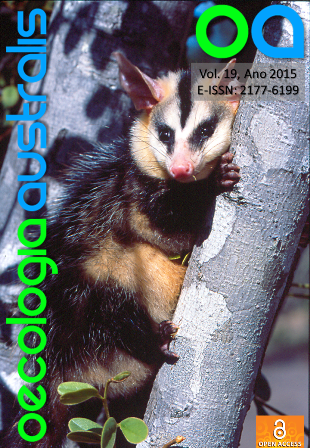POPULATION DYNAMICS OF Cerradomys goytaca TAVARES, PESSÔA & GONÇALVES, 2011 (RODENTIA: CRICETIDAE), A SPECIES ENDEMIC TO BRAZILIAN COASTAL SANDY PLAINS
DOI:
https://doi.org/10.4257/oeco.2015.1901.13Keywords:
Seasonality, Climatic factors, Population ecology, AdaptationAbstract
Restingas are coastal sandy plains that harbor peculiar ecosystems due to their soil and microclimates. These conditions favor the dominance of arid and semi-arid adapted plant species, even under humid tropical and subtropical climates, limiting the species richness of Neotropical small mammals. As the population dynamics of small mammals have been studied in only a few restingas, the influences of the environmental conditions of these physiognomies on mammal populations remain largely unknown. In this paper we describe the population dynamics of a restinga endemic rodent, Cerradomys goytaca, based on a capture-mark-recapture three-year study (2011-2014) conducted in the Restinga de Jurubatiba National Park, located in the northern littoral of Rio de Janeiro state. We investigated the putative effects of rainfall on population growth rate by testing different time-lag responses to precipitation and their relations with survival rates and previous population sizes. We also evaluated whether the demographic strategy of C. goytaca represent a putative specialization to the environmental conditions of restingas. Cerradomys goytaca exhibited relatively high survival rates between trimesters and seasonal population size fluctuations, with population peaks during the dry season, as observed in Atlantic forest small mammals. The best-fit model of population size variation corroborated the importance of a two-month time-lag effect of rainfall on population dynamics, but indicated a negative correlation of population size variation and survival rate with precipitation, suggesting that the population fluctuation of C. goytaca might be closely associated to the availability of resources positively influenced by dry periods. By combining a relatively high survival rate, a subtle population fluctuation and a negative time-lag influence of rainfall on population growth, C. goytaca exhibits a peculiar and slightly different demographic strategy in relation to the ones seen in other small mammals at similar physiognomies, suggesting this species as an interesting model to study the roles of the ecological singularities of restingas on its mammals.Downloads
Additional Files
- Cover Letter (Português (Brasil))
- camiladebarros, 960-6236-2-ED Reviewer B mod Nat.docx (Português (Brasil))
- camiladebarros, 960-6236-3-ED Reviewer E mod Nat.docx (Português (Brasil))
- camiladebarros, 960-6236-5-ED mod Nat.docx (Português (Brasil))
- camiladebarros, 960-6236-10-ED mod nat.doc (Português (Brasil))
- camiladebarros, 960-6236-7-ED.tif (Português (Brasil))
- camiladebarros, 960-6236-8-ED.tif (Português (Brasil))
- camiladebarros, 960-6236-9-ED.tif (Português (Brasil))
Published
2017-02-23
Issue
Section
Articles


